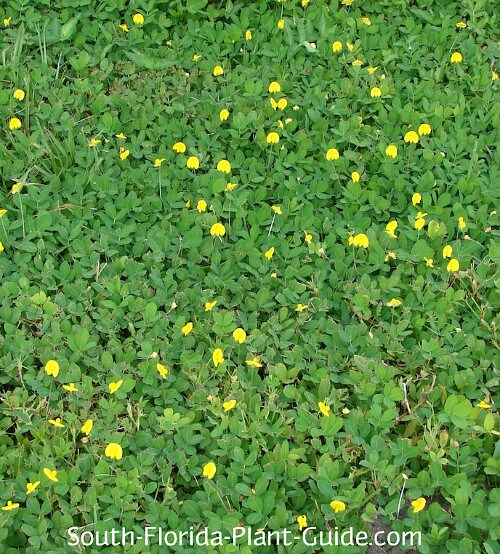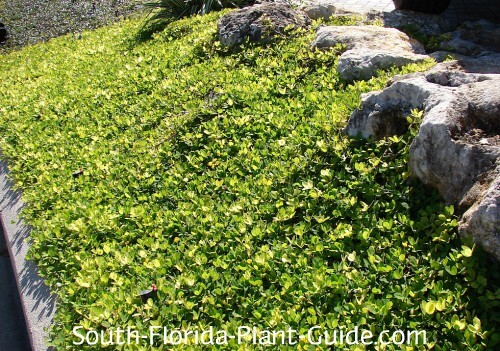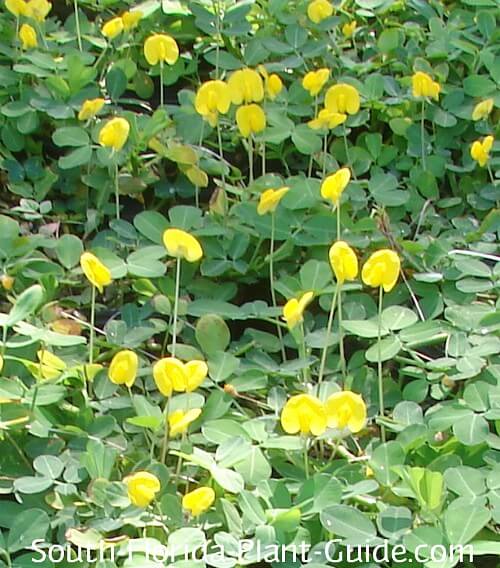Perennial Peanut
Arachis glabrata
Tired of mowing? The amazingly tough perennial peanut can replace your entire lawn - or parts of it - with beauty and style.

A relative of the edible peanut, this plant blankets the earth with flat-as-a-pancake foliage topped with tiny yellow flowers that appear on and off all year.
The dense foliage of mature plants will crowd out most weeds.
Of all South Florida's low growing groundcovers, this one probably takes the least care...and still looks fabulous. This plant is durable, tenacious and long-lived.
It can work not only as a complete lawn replacement but also in hard to mow areas like a small strip of lawn by a driveway.

These groundcover plants thrive on easements or surround tall palms or upright trees.
They can help prevent soil erosion on an embankment (place
along the top so the plants grow downhill).
As a deep border for a garden bed, perennial peanut creates a formal look, and it can also fill in around landscape boulders.
It's not necessary to do so but you can mow this plant once it's
mature. Set the mower blade for 3 or 4 inches, low enough to just nip
the tops of plants and encourage new growth and more flowers.
Infrequent foot traffic isn't a problem, but for higher foot traffic areas, add stepping stones or a pathway.
Plant specs
These groundcover plants are moderate growers that do best in full to part sun. They'll grow in part shade but the coverage won't be as thick.
Zone 10 is best, though in areas of Zone 9B that border Zone 10A established plants may come back in spring from a chilly winter. (There is a rhizomatous version of this plant that is cold hardy - it's often grown as a turf replacement and even for cattle feed in North Florida and other areas of the South.)

Plant care
Add top soil or organic peat humus to the hole when you plant.
Edging the planting area is the only trimming required - just to keep things neat and tidy.
As the plants become established, open areas of ground often sprout with weeds. Pull them by hand or mow over them, setting the blade so it hits the weeds but not the groundcover.
Once these plants are well-established, they're drought tolerant enough to need water just during dry spells. However, they'll do best with well-timed regular irrigation. Be sure to allow enough time between waterings for the soil to dry out.
Fertilize one time during growing season (late spring or early summer) with a quality controlled release fertilizer.
Plant spacing
Place plants about 2 to 3 feet apart. Come in from walks and drives at least 2 feet.
Perennial peanut is best suited to grow in the ground, rather than in a container.
A.K.A. (also known as): Ornamental Peanut
GOOD SNOWBIRD PLANT? YES
COMPANION PLANT SUGGESTIONS: Place near plants that won't reach out and create too much shade above the groundcover. Consider Red Cluster bottlebrush, croton, dwarf allamanda, eugenia, and thryallis.
Other groundcovers you might like: Asiatic Jasmine, Sunshine Mimosa
Take a break!
The ultimate guide to low-maintenance plants
and landscaping!
An ebook by
Chase Landre
author of
South-Florida-Plant-Guide.com
Learn more!
Get a greener thumb!
Want to learn more about South Florida planting, watering, fertilizing and dealing with weeds and pests?
See our Gardening How-To section for answers!
Get instant curb appeal!
An ebook by
Chase Landre
author of
South-Florida-Plant-Guide.com
Learn how to get instant curb appeal with fast growing plants and landscaping techniques!



